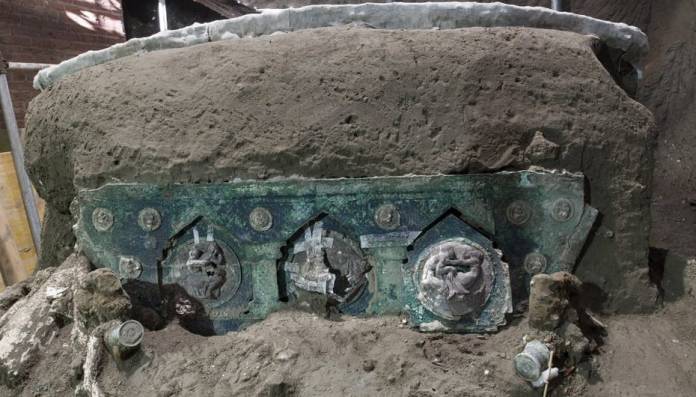
Researchers have unearthed a 2,000-year-old ceremonial chariot that was buried in volcanic ash in Pompeii in southern Italy. The buried chariot was made of bronze and tin and almost intact with four iron wheels, metal backrests, and armrests, as well as a seat upon which two persons could sit. The chariot was decorated with medallions that depicted love affairs and nymphs in what could have been a ceremonial purpose.
The rarity and ceremonial function of the chariot made Professor Eric Poehler of the University of Massachusetts Amherst call the find a Lamborghini. “I was astounded,” he said. “Many of the vehicles I’d written about before … are your standard station wagon or vehicle for taking the kids to soccer. This is a Lamborghini. This is an outright fancy, fancy car.”
Outgoing director of the Archaeological Park of Pompeii, Massimo Osanna, said the discovery will promote knowledge of ancient Italy and the Villa Arianna where the chariot was found. The Villa Arianna is located north of Pompeii in Civita Giuliana where a stable with some horses was unearthed in 2018. He stated that the find provides extra information to the ancient history of the buried villa that contained the chariot.
“It is an extraordinary discovery for the advancement of our knowledge of the ancient world,” Massimo Osanna said. “At Pompeii vehicles used for transport have been found in the past, such as that of the House of Menander, or the two chariots discovered at Villa Arianna, but nothing like the Civita Giuliana chariot.”
Researchers revealed that the ancient city of Pompeii was buried under volcanic ash from Mount Vesuvius almost 2,000 years before now and that new discoveries have included buried buildings, artifacts, and bodies of ancient Greco-Romans that used the streets of the city. In recent times, looters have dug underground tunnels to dig for artifacts and loot ancient treasures, effectively destroying the history of the ancient city in the process.
A UNESCO World Heritage site, tourists from all over the world come frequently to Pompeii to learn about its ancient history and witness some of the artifacts dug out from buried ash. The damage done by looters has compelled the Office of Torre Annunziata, officers of the Naples Carabinieri Headquarters for the Protection of Cultural Heritage, and officials of the Carabinieri Group Command of Torre Annunziata to constantly guard the ancient city of Pompeii against the activities of looters.
“The fight against the looting of archaeological sites, both inside and outside the urban area of ancient Pompeii, is certainly one of the primary objectives of the Office,” said Chief Prosecutor of Torre Annunziata Nunzio Fragliasso.
Source: cnn.com











